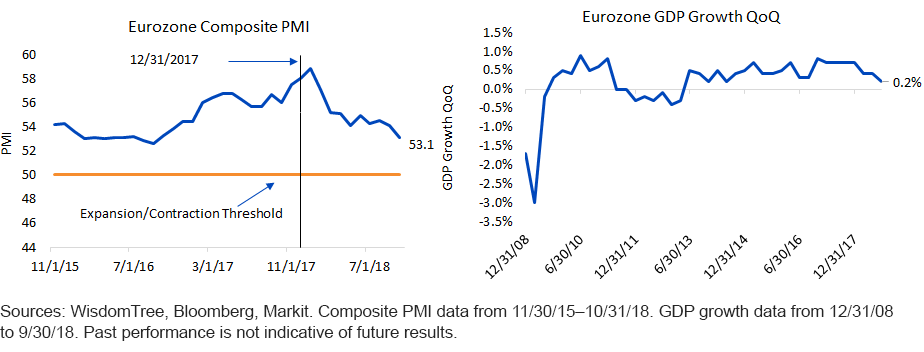
There’s no sugarcoating it: the performance of European equities in 2018 has been disappointing. The weak performance year-to-date, as measured by the -10.56% return for the MSCI Europe Index,1 has been accompanied by a marked slowdown in economic growth in the eurozone. Two major indicators used as bellwethers of economic growth, composite PMIs and real GDP growth, have both trended downward, albeit while still signaling economic expansion. Signs such as these—that this pullback is associated with weakening economic fundamentals—are cause for greater scrutiny for global asset allocators. Below, we discuss some ways investors may want to think about risk, and provide a few ways to diversify risk in Europe.

European Valuations: An Historical Review
For equity investors, particularly those with a long-term investment horizon, uncertainty tends to bring opportunity. Based on forward price-to-earnings (P/E) ratios, the MSCI Europe Index is currently priced, relative to the S&P 500 Index, at valuationsthat were last regularly seen in 2011, at the height of the European sovereign debt crisis. Today’s 16.1x forward P/E for the S&P 500 Index is an approximately 22% premium on the 13.2x forward P/E for the MSCI Europe Index.2
European equities tend to be more volatile than U.S. equities, and have thus traded at a chronic discount to their U.S. counterparts. Over time, the median ratio of the MSCI Europe Index forward P/E to the S&P 500 Index has been 0.86. Today’s ratio of 0.82 is nearly a full standard deviation below that median, signaling a potential buying opportunity. While the outlook for Europe is mixed, most notably due to Brexit, Italy’s budget and the end of quantitative easing, today’s valuations appear to appropriately compensate for those risks.
While short-term catalysts may prove illusive, most investors still maintain some exposure to Europe. In our view, an allocation to Europe blending large-cap multinationals that are directly tied to global growth with domestically-driven small-caps for a more balanced portfolio approach could add value in this type of environment.
















